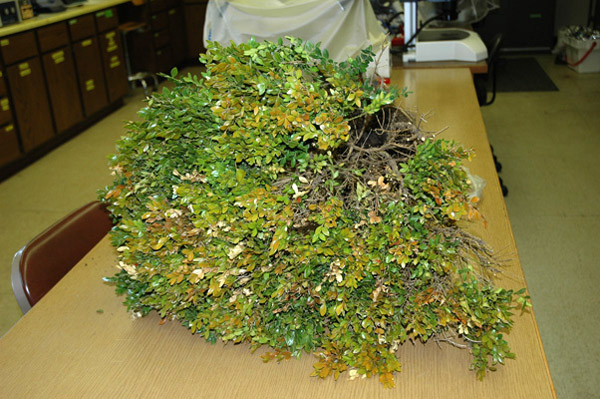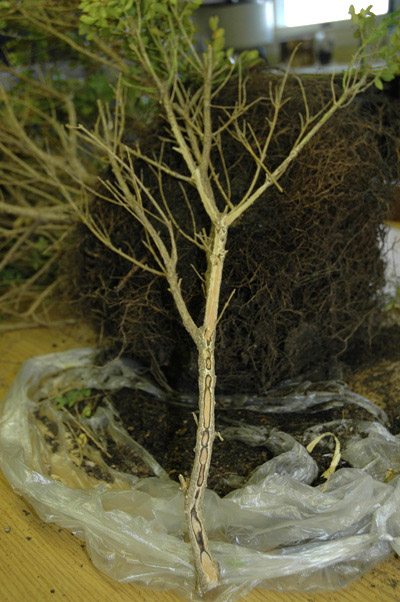Issue 2, May 1, 2009
Boxwood Bane
Many boxwood plants in Illinois (especially northern counties) have suffered the last two winters. I present this article as an aid, but certainly not as the answer to the problem. We have tested boxwood samples submitted to the Plant Clinic the last 15 months and have not recovered a primary pathogen to blame for the decline seen. We cannot survey the state, but work only with what is submitted.
We have observed bronzing of foliage, dieback of stems, bark blast near the base of the plants, blackened tissue in blasted areas, and mixed reviews on the condition of roots. The stem discoloration under the bark extended all the way to stem tips on some samples. Where I have had entire plants to dissect, the wood at the soil line seems normal, without discoloration. The images show the top of a recent boxwood sample and a stem with the black discoloration described.


Some boxwood species are injured by winter winds. Bronze foliage is often the result. The problems we have seen, and those discussed with clients by telephone, have been much more severe. Entire stems have died; and in some cases plants have died.
Boxwoods do not tolerate poor drainage. Northern Illinois has been soggy for long stretches in 2008 and 2009. This alone could be part of the problem. With wet soils comes a fungal-like disease called Phytophthora root and crown rot. There are ELISA tests available for the Phytophthora genus. We have not detected Phytophthora in samples submitted and tested with ELISA.
Verticillium wilt may infect boxwoods. It often causes discoloration like that seen on these stems. In several cases, where fresh material was submitted, we have cultured the stems on agar that would be more likely to recover this fungus. Verticillium has not been found to be the cause of decline.
We have consistently isolated either Volutella or Fusaria species from affected or dead stems. Both appeared on incubated stem and leaf tissues. Both of these genera of fungi are known to invade stressed boxwood plants. There are no fungicides available for control of this problem.
Based on the samples we have received, our lab tests, and communications with other diagnostic labs, it appears that pathogens have invaded following stress. The stress could vary with the site. In some cases it could be the extreme temperature change and loss of dormancy in the winter of 2008 and 2009. In some cases water stress may be the problem. In others salt may be an issue. If more information becomes available, it will be conveyed via this newsletter.--Nancy R. Pataky
Author:
Nancy Pataky